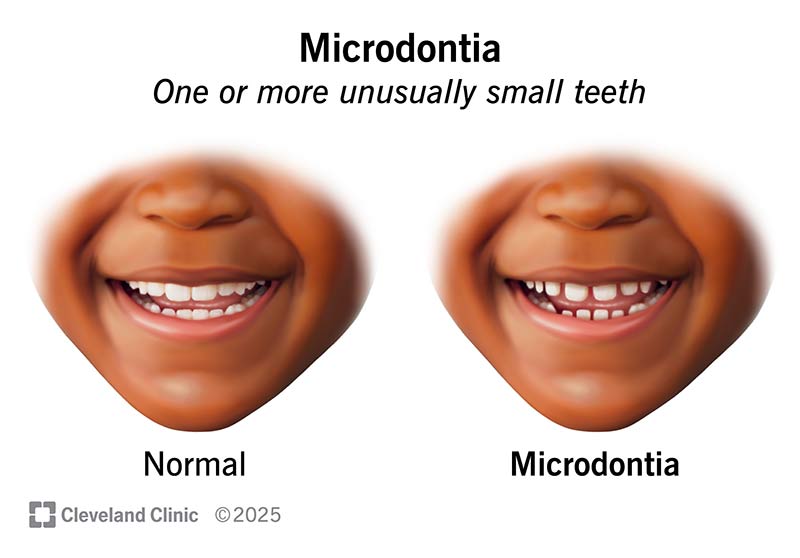Microdontia means “small teeth.” It’s a rare dental condition that can occur due to genetic or environmental factors. Microdontia doesn’t always require treatment. But if small teeth interfere with eating, speaking or other daily routines, a dentist can help.
Advertisement
Cleveland Clinic is a non-profit academic medical center. Advertising on our site helps support our mission. We do not endorse non-Cleveland Clinic products or services. Policy

If you have one or more unusually small teeth, you might have microdontia (mahy-kruh-DON-shuh). Microdontia is a condition that can happen when something disrupts tooth development. Sometimes, small teeth are related to another condition. Other times, they’re just a different version of normal.
Advertisement
Cleveland Clinic is a non-profit academic medical center. Advertising on our site helps support our mission. We do not endorse non-Cleveland Clinic products or services. Policy
Microdontia can affect any tooth, but some more commonly than others. The condition occurs in both baby (primary) and adult (permanent) teeth.
Microdontia is rare overall. Researchers estimate that it affects 1.5% to 2% of the general population. It’s a bit more common in females.
Microdontia might involve one tooth, several teeth or all your teeth. It depends on the type of microdontia you have:
Unusually small teeth are the main symptom of microdontia. Additional signs and symptoms may include:
Sometimes, microdontia is a stand-alone condition. But in some cases, it may be a symptom of:
Advertisement
Several things can cause microdontia, including:
Even if one or more of the above applies to you, it doesn’t necessarily mean that you (or your child) have microdontia. To get a better understanding of your situation, talk to your healthcare provider.
Healthcare providers can diagnose microdontia during a physical examination or dental cleaning. They may also need to take X-rays to check the health of your tooth roots.
Common microdontia treatments include dental procedures to make your small teeth appear larger. These treatments may include:
Dentists may use a combination of procedures to treat small teeth. Ask what they recommend in your situation.
Braces can’t fix microdontia directly, but they may be part of your treatment plan. For example, if your small teeth cause crowding, braces might be used to create space before other treatments. Ask your dentist if braces are right for you.
Tell your dentist if you develop jaw pain or notice signs of wear or tear on your teeth. If you don’t already have a dentist, ask your primary care physician for recommendations.
Microdontia doesn’t always need to be fixed. If you only have one or two small teeth, you might not need treatment at all. But if the condition disrupts your quality of life, consider talking to your provider.
Having smaller-than-normal teeth isn’t something that always requires treatment. But if you have difficulty eating or speaking — or if you simply want your teeth to appear larger — talk to your dentist. They can discuss options with you and come up with a plan that fits your goals.
Advertisement
Dentistry plays an important role in oral health. Cleveland Clinic’s experts can design a personalized plan that will keep you smiling for the long haul.

Last reviewed on 06/18/2025.
Learn more about the Health Library and our editorial process.